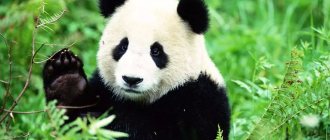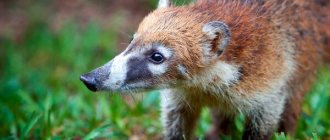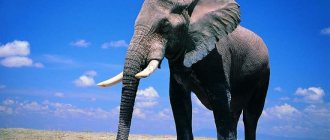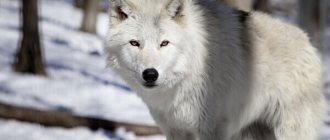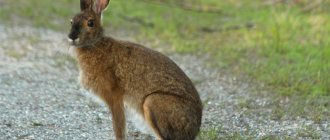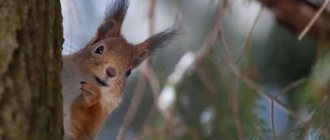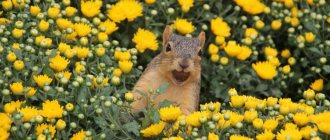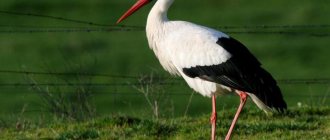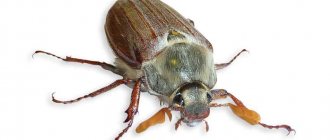Raccoons are a genus of mammalian predators. For a long time, there was a debate in the scientific community about the belonging of the genus to canines, felines or mustelids. In the 18th century, the raccoon family was introduced into the biological classification, which currently includes four species of raccoons, the Central American and North American raccoons, several species of olingo and nosuha.
Raccoons are considered valuable fur-bearing animals. Raccoon fur is one of the most wear-resistant, it repels moisture well, retains heat, and is lightweight and beautiful.
Description, structure, characteristics
The name "raccoon" comes to us from the Indian word "Arakun", which translates as "scratching with one's hands."
Raccoons are carnivorous mammals belonging to the raccoon family, which includes four species of these animals (we will describe each species in more detail below). Also close relatives of raccoons are raccoon dogs (they are often confused with raccoons), nosuhi, kakimitsli and kinkajou. And the raccoon’s distant relatives even include dogs and pandas.
The most common among raccoons is the raccoon, which is also called the “gargle bear” or “washing bear.”
The body length of raccoons is usually 45-60 cm; the average weight of a raccoon, depending on the species, can vary from 2-5 to 8-15 kg. Moreover, males are often larger than females. The body structure of raccoons is a bit like
a fox or a dog. But the paws of a raccoon are an important distinguishing feature of these animals; they have very elongated pads, somewhat reminiscent of human palms. Thanks to the similar structure of their paws, all raccoons have excellent grasping abilities.
Raccoons climb trees with ease and can manipulate various small objects.
A raccoon's tail is long and usually bushy. A raccoon's fur depends on its species; for example, the raccoon's fur is short, while the raccoon's, Cosemelle and Guadalupe raccoons' fur is, on the contrary, longer and fluffier. As for color, all raccoons are grayish-brown in color, and their tail is painted with transverse black and white stripes.
The raccoon's head is very wide, has a short and sharp muzzle, and small and rounded ears.
Interesting fact: all raccoons not only climb trees with ease, but also swim well, and can swim even in cold water, which is facilitated by the special composition of their fur, consisting of 90% thick undercoat, as if specially adapted by nature to protect against cold water.
Lifestyle
The animals have a fairly peaceful character, while maintaining high activity and curiosity. Among other animals, raccoons are valued for their enviable intelligence, and therefore they are easily amenable to simple training. Due to their character, raccoons will subsequently perform any tricks and commands with great pleasure.
Pros and cons of raising raccoons at home:
Learn and adapt quickly
Get along well with other animals
They are truly omnivorous, so you don’t have to spend money on buying expensive specialized food
May be afraid or wary of young children
In dangerous conditions, people are prone to display aggression
They gain weight very quickly, so you need to carefully monitor your diet
Despite their peaceful and friendly nature, raccoons can easily fend for themselves. To do this, they use the best “universal” weapons, namely teeth and claws.
When attacked in this way, the animals will make threatening sounds, which in many ways resemble a growl. In the vast majority of cases, raccoons are not the instigators of conflict. They prefer to either escape from the scene in time, or pretend to be dead, and very skillfully.
Despite their friendly disposition, raccoons tend to lead an isolated lifestyle. They can indeed form small groups, but in rare cases. For example, shortly before the breeding season or before wintering.
It is worth noting other character traits that influence lifestyle:
- each individual has its own separate territory;
- when meeting with relatives, raccoons behave peacefully, without threatening, and therefore territories intended for obtaining food may well overlap;
- Due to their enviable tolerance towards their fellow tribesmen, they usually have a relatively high population density.
When meeting each other, raccoons will purr friendly, chirp sweetly, or squeal slightly.
Other features of life
Mammals become active with the arrival of evening and twilight. That’s why you hardly see them during the day – they sleep in their burrows.
Their lifestyle is directly dependent on a number of factors. This is also influenced by the habitat, and therefore active and walking raccoons can be seen during daylight hours.
Raccoons lucky enough to be born on the coast will be heavily influenced by the tides. If we talk about raccoons, which typically live in northern latitudes, at the initial stage they will stock up on fat. And only after that they hibernate - exactly for that period of time how long the winter will last.
Mammals living in the south are active throughout the whole year. While individuals living in the north may not come to the surface for a long time at subzero temperatures. Periods of such calm sometimes last for weeks or even months.
Moreover, all this time the raccoons will sleep soundly.
However, such a state can hardly be called actual hibernation. The fact is that the body’s metabolism practically does not slow down, just as the heart rate does not decrease. Therefore, experts tend to consider this a temporary anabiosis.
It is noteworthy that:
- the duration of such selective sleep will directly depend on the onset of cold weather;
- the longest duration was recorded in Canadian raccoons - in their case, sleep is no more than four to five months;
- In the southern region, striped raccoons do not sleep at all; they tend to wait out the period of active snowfalls without leaving their “house.”
Interestingly, raccoons tend to wait out such bad weather and other unfavorable conditions in whole companies or even in packs - up to 10 or more individuals.
Habitats
Where do raccoons live? Raccoons are native to North and South America and can be found in forests from Canada to Argentina. With the discovery of America by Europeans, raccoons came to Eurasia and one of their species, the striped raccoon, was able to take root quite well in our latitudes. In particular, populations of the striped raccoon have been created in many European countries and also in the Caucasus.
As for our country, Ukraine, in the hometown of the author of the article - Lviv, there is a whole raccoon farm - “
Raccoon House”, that is, you can come to visit the raccoons, play with them; such an event will definitely be unforgettable for children. To learn more about the “Raccoon House” in Lviv, follow the link.
Raccoon's house.
Night vision
Raccoons have an excellent ability to see perfectly in the dark. They also have excellent hearing. The raccoon is a predator that prefers to hunt at night. This is where he needs these features.
Interesting. A raccoon can reach speeds of up to 24 km/h even in pitch darkness.
Character and lifestyle
Raccoons have a friendly character, they are peaceful, active and inquisitive. However, despite their peacefulness, they are not cowardly, therefore, in case of danger, they are able to bravely defend themselves, bite and scratch. They can also rumble threateningly, trying to scare a potential enemy. In particularly dangerous situations, raccoons may flee or resort to a cunning trick - pretending to be dead.
Despite their friendliness and sociability, in natural conditions raccoons prefer to lead a solitary lifestyle, coming together only for mating and during hibernation. And yes, raccoons, like
Bears go into hibernation in winter, and the biological mechanisms of hibernation in raccoons are similar to those of bears; hibernation itself in raccoons lasts depending on the duration of the cold period. Canadian raccoons sleep the longest, in which hibernation can last up to 5 months, but raccoons living in the warm tropics of Central America do not hibernate at all, due to the lack of winter in their habitats.
Sleeping raccoon.
Raccoons are crepuscular animals, which means they are most active in the evening and at night, preferring to sleep in their cozy den during the day. But when evening comes, they go out in search of food. Although, if necessary, these animals can change their established daily routine.
Raccoon diet
The main natural habitats of raccoons are forested areas bordering various bodies of water or marshy areas. As a rule, forests have a sufficient number of hollow, old trees where a raccoon can rest during the daytime. This nocturnal predator has excellent night vision, which allows the animal to easily navigate in space and find food for itself. Moreover, the raccoon has sensitive vibrissae that grow on almost the entire surface of the body.
The raccoon is an omnivore, but its diet largely depends on its habitat. Since raccoons hibernate during the winter, when spring comes they need nutritious, high-calorie food. Immediately after hibernation, which occurs in February-March, the breeding season of raccoons begins. This process requires a lot of strength and energy, so their diet consists of high-quality protein foods, which can only be obtained from food items of animal origin.
Important point! Some anthropogenic factors that have been critical in nature relative to the overall abundance of various animal species have not had such a significant impact on raccoon populations. Raccoons have quite easily adapted to the extreme conditions of living next to humans and are accustomed to getting food for themselves in landfills or trash cans.
Raccoons hunt large insects, as well as small rodents and frogs. Raccoons deftly climb trees, so their prey can be bird eggs and chicks. Raccoons often hunt snakes and lizards, as well as various living creatures that live in bodies of water, such as crabs, crayfish, fish, etc. At the end of summer, when the fruits of various trees and shrubs ripen in the forests, they switch to feeding on nuts, acorns, berries, etc. For some countries, raccoons pose a serious threat because they raid plantations of various crops.
Enemies in nature
In turn, raccoons themselves can become prey for other larger predators: bears,
wolves, lynxes, coyotes, wolverines and cougars. In an attempt to escape from their enemies, raccoons often resort to trickery - pretending to be dead, but when this trick does not work and it is not possible to escape, they desperately resist, fighting with all their might for their lives. However, unfortunately, this is not always possible.
Also, to a certain extent, humans are the enemy of raccoons; American Indians sometimes killed these animals for their fur. Later, white colonists also began to practice hunting raccoons. Fortunately, the active reproduction of these animals has not put their population at risk.
LiveInternetLiveInternet
Friday, August 07, 2015 01:02 + in quotation book TYPES AND HABITAT OF RACCONS Family Raccoonidae (Procyonidae) The family of raccoons, limited in the number of species, unites animals of various appearances. The main part of them is of medium size, with an elongated flexible body 31-67 cm long, a long (from 20 to 69 cm) tail, and in some climbing animals it is prehensile. Weight ranges from 0.8 to 22 kg. The muzzle in almost all species is short, pointed, and the ears are erect. Paws with long, prehensile toes, plantigrade or digitigrade, sometimes with semi-retractable claws. The color of most species varies from gray to bright reddish-brown, there are often markings on the face, and a ringed tail pattern is characteristic. There are 11 - 12 species in the family, grouped into 8 genera (map 8). The family is clearly divided into subfamilies of American and Asian raccoons. The first includes the vast majority of species inhabiting South and Central America, and one species from North America. The second subfamily includes only 2 species, limited to a narrow range in East Asia. The red panda, along with the giant panda, are the only representatives of the raccoon family in the Old World. It lives in the mountain forests of some regions of China, Burma, Sikkim and Nepal. LESS PANDA (Ailurus fulgens) The red panda (Ailurus fulgens) is a medium-sized animal: 51-64 cm long, with a tail measuring 28-49 cm, weighing from 3 to 4.5 kg. The panda's body is elongated, covered with long soft fur, the tail is fluffy, the head is wide, with a short sharp muzzle, and large pointed ears. The paws are short, strong, with large semi-retractable claws. The panda is red or hazel above, dark, reddish-brown or black below; its paws are black, its tail has a ringed pattern, its head is light, with the edges of its ears and muzzle almost white, and near its eyes there is a spotted pattern in the form of a mask. The red panda only has 38 teeth. Its multitubercular molars are adapted to grinding plant foods. The panda is active at night and sleeps in a tree during the day, curled up in a ball. In case of danger, she also climbs trees. The animal has a gentle disposition, does not fight when caught and is quickly tamed. This animal of the raccoon family lives in China, Nepal, Burma and India. This panda cannot be found west of Nepal. The red panda lives in forests on the eastern slopes of the Himalayas and the nearby mountains of Western China. The habitat of the red panda is limited to the provinces of Yunnan and Sichuan in China, Northern Burma, and Nepal. It lives in mountain bamboo forests at an altitude of 2000-4000 m, in a temperate climate. The animal is small, with a tail about a meter long, the fur is thick and fluffy, which is why the red panda seems larger than its true size. Her outfit is very colorful. During the day it sleeps in a hollow or in the fork of a tree; at dusk it awakens, waddling, looking for acorns, roots, lichens and, most importantly, bamboo shoots, juicy and young. With every, even fleeting, alarm, it takes refuge in the trees. And if the path to retreat is cut off, it defends itself desperately, fighting back with paws with sharp semi-retractable claws. The defense methods are similar to those of a bear, but the claws are more likely to be cat-like. Red pandas often live in pairs or families, never in packs. Their cry is loud, some kind of bird screeching. When calm, it makes short sounds and squeals when caught. The panda feeds mainly on the ground on bamboo shoots, grass, roots, fruits, and seeds. Sometimes it eats eggs and birds themselves, as well as small rodents. Pandas live in pairs or broods, which usually have 1-2, very rarely 4 cubs. They are born in a hollow or rock crevice after 90-150 days of gestation, apparently having a latent stage. The young begin to see clearly after 3-4 weeks and remain with their mother until the next litter. According to some reports, both parents take care of the young. The giant panda (Ailuropoda melanoleuca) has an even more original appearance. As we have already noted, she looks more like a bear cub. . It’s not for nothing that this panda is called a bamboo bear, and some zoologists even classify it as a member of the bear family. The giant panda reaches 1.2-1.5 m in length and weighs from 17 to 160 kg. Its massive body, covered with thick fur, rests on short, thick legs with wide paws armed with strong claws. On the soles and at the base of each toe, bare pads are well developed, making it easier to hold the smooth bamboo stems. The giant panda's head is massive, blunt-faced, with large ears. The panda is distinguished from bears by its rather long (12 cm) tail. The coloring of this animal is mainly white, but with black spots (“spectacles”) around the eyes and black legs; at the same time, the black coloring of the forelimbs merges with a wide “collar” of the same color that encircles the body over the shoulders. Apparently, such an unusual coat color has a camouflage, or protective, meaning. The giant panda became known only in the middle of the last century. Naturalists first observed a living panda in nature only in 1913. It is one of the rarest, poorly studied large animals, which is facilitated by a secretive lifestyle. The giant panda is found only in the mountain forests of several western provinces of China (Sichuan, Gansu, Tibet). Mainly solitary except when mating in the spring and raising young, which are born the following winter, usually in January. There are 1-2 of them, each weighing about 2 kg. The giant panda does not hibernate, but is active all year round, spending 10-12 hours feeding every day. It feeds mainly on thin sprouts and partly on bamboo roots, and in addition, on various other plants, and occasionally on animals, in particular fish, pikas and small rodents. Apart from two pandas, there are no other raccoons in the Old World. But in America there are 16 species. Raccoon. Photo: Gilles Douaire Raccoons are plantigrade, like bears, their claws are semi-retractable, some semi-plantigrade, or non-retractable. In some ways they resemble small bears, but in some ways they also resemble martens, although in general they are animals of a special family. The most famous of the raccoons (especially to those who often visit stores selling fur coats) is the striper, or washer, as furriers and Germans call it. They nicknamed him the gargle for his strange habit - to “wash” all his food and various inedible objects in water, when it is nearby. He rinses, rubs, lowers, and again catches with his front paws everything he wants to eat, so carefully and for a long time that you can’t call it a random whim. But what biological meaning this has is unclear. Some raccoons in captivity even wash their newborn cubs, and so senselessly diligently that they sometimes die after being “washed.” The homeland of this raccoon is the USA, the southern provinces of Canada, Mexico and Central America (south to Panama). It is the size of a fox, brown-gray, with a “mask” of black stripes on its face. Tail with four to six dark rings. The claws are non-retractable. Our raccoon dog is exactly like a raccoon dog, and in its habits it resembles its neighbor, the opossum: it is also omnivorous, it also often carries chickens, it jumps and climbs trees just as deftly. Sometimes, like a sloth, he even crawls with his back down a thin branch, fingering it with his paws. He’s also quite good at playing possum, pretending to be dead when his escape routes are cut off. And just like an opossum or, say, a bear, it sleeps in hollows in winter where the winters are cold. A cheerful, lively, playful, curious and gentle animal. Active at night, sleeps in a tree during the day, and less often in a badger hole. It swims well, and at low tide raccoons travel far beyond the receding sea - they catch crabs and fish in small lagoons and depressions filled with water. Cubs - two to eight. They will be born in April - early May. Our zoologists have quite successfully acclimatized American raccoons in many places in Russia: in the Krasnodar and Stavropol Territories, and in the Primorsky Territory. However, “in the latter region,” writes G. A. Novikov, “acclimatization is proceeding unsatisfactorily.” In addition, raccoons that escaped from fur farms have acclimatized in Germany: Hesse, Westphalia and Lower Saxony. On an area of 50 thousand square kilometers, about a thousand raccoons live here in the wild. And about half a thousand more - east of Berlin. Americans brought raccoons to Alaska and the Bahamas. On these and some other islands (Guadeloupe, Barbados, Las Tres Marias), according to American experts, five species of raccoons close to the striper, but special, live. Apparently, these are still only varieties: subspecies or races of the striper. The most favorable conditions for the raccoon are mixed forests with old hollow trees located near ponds and swamps. It is not hampered by the proximity of populated areas. It makes its homes in hollows, rock crevices, sometimes in its own or other people's burrows, and even in piles of brushwood. Within a radius of about 1.5 km from its shelter, a raccoon wanders at dusk and at night in search of food. It climbs trees well, but usually feeds on the ground, in swamps and shallow waters. Its food includes frogs, crayfish, fish, rodents (even young muskrats), as well as all kinds of berries, acorns, nuts, and fruits. Before eating prey, the raccoon rinses it in water, which gives rise to the name it is called a gargle. The striped raccoon is the only member of the family that goes into a long sleep during the winter. In Canada it lasts 4 months, but in more southern areas it is observed only while there is snow and frosty weather. Depending on the area where they live, mating in raccoons occurs in winter or early spring, and in some cases in summer. Pregnancy lasts 63 days. They receive their sight on the 20th day; at the age of 4-5 months they obtain food on their own; They reach sexual maturity after a year. The striped raccoon belongs to valuable fur-bearing animals. In some countries it is even bred on farms. In Central and northern South America, there is a crabeater raccoon (P. cancrivorus), close to the striper, distinguished by an elongated body, smooth short fur, and a non-furry tail. In terms of lifestyle, in particular nutrition, the crab eater is similar to the minnow.
https://www.youtube.com/watch?v=xA9RU9amcMw If you remove the fluffy coat from the striper (and from the tail too) and dress it in sparse and short fur, you will get an animal that looks like a crabeater. That is why the skins of crabeaters are not valued by furriers and are not among the millions of raccoon skins that are sold every year in the fur markets in the United States alone. Crabeater raccoons are not found in North America. Among other American species, one should name the peculiar kakimitsli (Bassariscus astutus), whose appearance is partly similar to a marten, partly to a cat. It is slightly larger in size than a squirrel: its fluffy tail is 37 centimeters long, everything else is about the same. Yellowish-gray, the ears are large, and the tail is completely, from root to tip, in black and white rings. A very impressive tail. A forest animal, it climbs trees no worse than a squirrel, but also lives in rocky deserts, in bushes and on hills. Shy, cautious and only hunts for prey at night; therefore, even where there are many “cat squirrels”, people rarely see them. The larger gray camomitsli lives in Central America. Cacomitsli is found in southern North America in dry, rocky places. He climbs trees well and lives in hollows, among stones, in ruins and abandoned huts. In summer it feeds mainly on insects and plants, in winter on rodents. At the beginning of summer, kakimitsli gives birth to 3-4 small cubs, which in a little over a month behave like adults. In Central America, there is another species of kakimitsli (Jentinkia sumichrasi), which is more fluffy and has larger ears. It is even better suited to a climbing lifestyle. In addition to stripers, crabeaters and camomitsli, the raccoon family includes three more species of noses, or coatis, kinkajous and three species of olingos (some live in South and Central America, and one species of noses lives only on the island of Cozumel, east of Yucatan) . In the subtropical and tropical forests of the southern United States and South America, three species of noses, or coatis (genus Nasua), live: N. narisа, N. nasua, N. nelssoni. Among them, the first two are especially famous. The noses reach a length of 67 cm, not counting the tail (it is about 59 cm), and have a mass of about 11 kg. The body of the noses is elongated, on strong legs, covered with short red hair on top and light below. They received their Russian name for their very long muzzle with the long end of the nose constantly in motion. The tail of the nose is long, non-furry, with a typical ringed pattern. Coatis (Nasuella olivacea) are very active small raccoons that spend the whole day worrying about food. With their tails raised high, they dig the ground long muzzles or movable noses, others prefer to look for prey in the trees. As soon as they sense danger - a loud whistle, the whole flock is in the trees. And at night, coatis sleep - also in the trees. Coatis are active either during the day or at night. Unlike other species of this family they live not only alone, but also in groups of 5-6 and even, as some naturalists report, up to 40 individuals. All kinds of small animals, partly plants, serve as food for noses. Sometimes they harm field crops and poultry production. In spring or summer, after a 77-day pregnancy, females give birth to 2 to 6 cubs. Unlike the nose, the kinkajou (Potos flavus) has a rounded head, round ears, a prehensile tail, and thus partly resembles a monkey. The kinkajou is a small, gray-red animal. The tail is its most remarkable feature. Only the binturong, a South Asian animal from the civet family, has a tail so capable of firmly grasping branches. None of the predators have any more. The kinkajou's tongue is also notable, it is long and thin. That tongue can squeeze into any gap and extract as much honey as the animal wants. Honey and fruits are his delicacy. But the prehensile-tailed raccoon also destroys bird nests and, on occasion, eats various small animals. Kinkajou is good-natured and playful. It gets used to people quickly; tame kinkajous often live in Indian villages. The second name of this animal is potto. This is also the name of a lemur in Africa, potto, which is a strange thing! - looks a little like a kinkajou, although it is not at all related to it. The Olingo, especially the Allen's Olingo, is similar to the kinkajou, and it is not uncommon for both to live peacefully in the same tree. The Indians consider both to be one beast. But the olingo is a different animal, and its teeth are arranged differently, its muzzle is longer, and its tail is non-prehensile; Having grabbed a branch with it, like its fifth paw, the olingo cannot hang like a kinkajou. That's all raccoons; there are no others on Earth. Sources used: https://biofile.ru/bio/2298.html https://udivitelno.com/animals/item/469-enot-poloskun https://enc-dic.com/enc_biology/Semestvo-enotove-rrocyonidae -1612.html
| Categories: | Fauna. Stories about animals. My Messages |
Tags:
animals raccoons habitat types
Cited 1 time Liked by 1 user
Like share
0
Like
- 1
I liked the post - Quoted
- 0
Saved
- Add to quote book
- 0
Save to links
Liked1
0
Types, photos and names
As we wrote above, there are 4 types of raccoons in nature, and below we will describe them in more detail:
Raccoon gargle
This raccoon got its unusual name due to its habit of rinsing caught prey in water. Thus, the clean raccoon cleans it of sand. It is also the most common among raccoons, found throughout North and Central America, and more recently in Europe. Everything we wrote above concerns primarily raccoons.
Racoon crayfish (aguara)
A distinctive feature of this raccoon is a characteristic pattern around the eyes, somewhat reminiscent of a bandit mask. This raccoon has shorter fur and a more streamlined body. It got its name from its gastronomic love for crayfish. Lives in the jungles of Central and South America.
Cozumel raccoon
This species of raccoon is very rare, as it lives in a limited area, namely on the small island of Cozumel in the Caribbean Sea. It also differs from its other relatives in its brownish-grayish fur and the presence of a yellow tint on the tail.
Guadalupe raccoon
This species of raccoon is currently critically endangered and is listed as
Red Book. It lives in the humid areas of Guadeloupe, preferring to settle in marshy areas, as well as near reservoirs, rivers and lakes. Its appearance is similar to a striped raccoon.
Family Raccoon
The family unites animals with different external characteristics. Most of them are medium-sized animals with a flexible and elongated body from 31 to 67 centimeters long and a long fluffy tail (20-69 cm); in some climbing members of the family it performs a grasping function. The body weight of animals varies from 0.8 to 22 kg.
Almost all species (with a few exceptions) have a pointed, short muzzle and erect ears. The paws have a characteristic structure: tenacious and long fingers, plantigrade, less often with semi-retractable claws. In most species, the color varies from light gray to bright reddish-brown. There are almost always marks on the muzzle, and the tail pattern is ringed.
Reproduction
Raccoons breed strictly once a year, during their mating season, which occurs either at the end of winter or at the beginning of summer (depending on the raccoon’s habitat, the further south it lives, the faster its mating season begins, for raccoons living in our temperate latitudes, the mating season is in early summer).
These animals have no special mating rituals, everything is extremely simple - the male finds the female by smell and mates with her. The pregnancy of a female raccoon lasts 2 months; birth occurs in some secluded place, usually a hollow tree or an abandoned hole of another animal.
From 3 to 8 small raccoons are born at a time. Baby raccoons, like kittens, are born blind and helpless, and at first they are under the full care of their mother, who feeds them with her breast milk. But after a month of their life, they begin to grow rapidly, by 4-5 months they are already able to obtain food on their own, and by the first year, raccoons reach sexual maturity and become adults.
Raccoon (Procyon lotor)
This species is common in North America, found in Europe and even in China. The striped raccoon, or American raccoon, is easily tamed and is perfect for breeding in captivity. In the wild, it settles close to bodies of water.
Interesting fact
These curious animals were nicknamed rinsers because of their very strange habit of washing everything. Raccoons rinse their food especially carefully. Even if the prey was caught in an open reservoir, before eating the animal will definitely rinse the food in the water again.
The body length of adult individuals reaches 45-60 centimeters, the tail is 20-25 centimeters. Gargles weigh 5-9 kilograms. The fur of these raccoons is distinguished by a brown-gray color; characteristic dark spots in the form of a mask can be seen on the muzzle around the eyes.
Predators feed on animal food and plant foods. They lead a solitary lifestyle and go into shallow hibernation during the winter. Wolves, coyotes, owls can attack raccoons, and snakes also pose a danger to young animals.
The mating season begins in February-March; pregnancy in females lasts 63 days. In one litter, from 3 to 7 babies are born. At the age of 5 months, the young begin an independent life.
The striped raccoon is a valuable fur-bearing animal.
Zoologists distinguish 22 subspecies of Procyon lotor, namely:
- Procyon lotor auspicatus;
- Procyon lotor elucus;
- Procyon lotor excelsus;
- Procyon lotor fuscipes;
- Procyon lotor gloveralleni—Barbados raccoon (extinct);
- Procyon lotor grinnelli;
- Procyon lotor hernandezii;
- Procyon lotor hirtus;
- Procyon lotor incautus;
- Procyon lotor inesperatus;
- Procyon lotor insularis - Tresmarias raccoon;
- Procyon lotor litoreus;
- Procyon lotor lotor;
- Procyon lotor marinus;
- Procyon lotor maynardi - Bahamian raccoon;
- Procyon lotor megalodous;
- Procyon lotor pacificus;
- Procyon lotor pallidus;
- Procyon lotor psora;
- Procyon lotor pumilus;
- Procyon lotor simus;
- Procyon lotor vancouverensis.
Raccoon gargle not at the Christmas tree
Keeping at home
Raccoons make excellent pets due to their friendly nature. Just don’t get a raccoon if you live in a cramped apartment, since these animals need space, and they won’t be free-range like cats or dogs either.
It is very advisable to allocate a whole separate room for the raccoon; it will also be its enclosure, in which the animal will feel free. Since raccoons are very smart animals, you can have fun and play with them, but you should also be careful, because if the raccoon thinks that it is in danger, it can bite and scratch. Raccoons are especially aggressive during their mating season. Also, during the mating season, a male raccoon can mark his territory, which will be fraught with a very unpleasant odor. But in general, a raccoon can be trained to go to the litter box, almost like a cat or dog.
It is also worth considering that raccoons can be very mischievous, even hooligan animals; while living in a house, they can do all kinds of mischief, for example, break all the dishes in the kitchen, throw over an expensive TV, and so on. To avoid this, they should not be released from their enclosure room (at least without supervision), having first removed all valuable items from there.
And raccoons are crepuscular animals, which means that if you have such a pet in the house, you will need to adapt to its natural rhythm; the raccoon will most likely sleep during the day, but get rowdy in the evening and at night. You will also need to feed him in the evening and at night, in general, if you are a “night owl” according to your biorhythm, then with a raccoon it will be easier for you than for people who are “larks”.
Raccoon as a pet
Cute and smart raccoons leave no one indifferent. It is not surprising that recently more and more people keep them as pets. Before you decide to purchase such a pet, you should take into account all the difficulties that are usually associated with keeping a raccoon.
Raccoons give the impression of cute and funny little animals, but do not forget that by their nature they are a wild predator. If you do not accustom it to yourself before puberty, the matured animal will definitely show its character: raccoons become aggressive not only towards strangers, but also towards their owners. The animal requires a lot of attention. You should not take a raccoon into your home if you are not willing to spend 3-4 hours a day with it.
Raccoons are curious and energetic animals. While awake, they are constantly on the move, exploring everything around them. An animal left unattended can ruin things and food, unscrew a water tap or chew through wires. When keeping the animal indoors, it is recommended to lock the animal at night and while away from home in an enclosure.
The enclosure must be spacious enough for the pet to move freely. Inside you need to place a tray, bowls with water and food, a resting house and a large bowl or bathtub with water in which the raccoon will wash the food. With proper and regular care, the animal does not have an unpleasant odor.
The diet of a raccoon in captivity can consist of minced meat and fish, eggs, cereals, fruits and vegetables.
CHINCHILLA
What to feed
What to feed your pet raccoon? A partially omnivorous raccoon can be fed with the same things it has in its natural environment: these are various berries, fruits, and nuts. In addition, raccoons can be fed with specialized food for cats and dogs, but only premium food. You can give meat and fish, both raw and boiled, the main thing is not too fatty. Chicken, beef, turkey, veal and rabbit are excellent meats for raccoons. Raccoons eat excellent fruits: apples, pears, grapes, bananas, peaches, plums. Vegetables that will be useful to raccoons include: carrots, fresh peas, asparagus, and zucchini.
Interesting Facts
Swimming ability
Every raccoon simply loves water and everything that can be connected with it. These animals will definitely rinse their food in water if possible.
Just like otters, these animals settle closer to bodies of water. They are excellent swimmers, but very lazy. The mother begins to teach her babies to swim almost after birth, the babies begin to play on the shoreline in search of frogs and snails.
Interesting. They can spend three hours a day in water.
Video
And finally, an interesting documentary about raccoons.
Author: Pavel Chaika, editor-in-chief of Poznavaika magazine
When writing the article, I tried to make it as interesting, useful and high-quality as possible. I would be grateful for any feedback and constructive criticism in the form of comments on the article. You can also write your wish/question/suggestion to my email [email protected] or Facebook, with respect, the author.
Author page
This article is available in English -
Raccoon.
